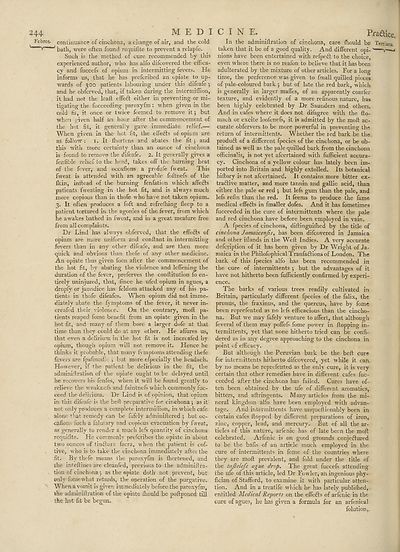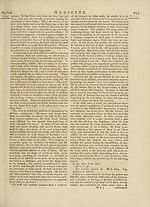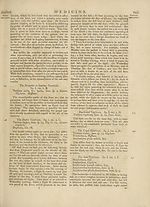Encyclopaedia Britannica, or, a Dictionary of arts, sciences, and miscellaneous literature : enlarged and improved. Illustrated with nearly six hundred engravings > Volume 13, MAT-MIC
(286) Page 244
Download files
Complete book:
Individual page:
Thumbnail gallery: Grid view | List view

244
Fcbres. continuance of cinchona, a change of air, and the cold
v ’ bath, were often found requilite to prevent a relapfe.
Such is the method of cure recommended by this
experienced author, who has alfo difcovered the effica¬
cy and fuccefs of opium in intermitting fevers. He
informs us, that he has prefcribed an opiate to up¬
wards of 300 patients labouring under this difeafe ;
and he obferved, that, if taken during the intermiffion,
. it had not the lead effeft either in preventing or mi¬
tigating the fucceeding paroxyfm: when given in the
cold fit, it once or twice feemed to remove it; but
when given half an hour after the commencement of
the hot fit, it generally gave immediate relief.—
When giv’en in the hot fit, the eifedfs of opium are
as follow : 1. It ffiortens and abates the fit •, and
this with more certainty than an ounce of cinchona
is found to remove the difeafe. 2. It generally gives a
fenfible relief to the head, takes off the burning heat
of the fever, and occafions a profufe fveat. This
fweat is attended with an agreeable fottnefs of the
Ikin, inttead of the burning fenfath n which affedls
patients fweating in the hot fit, and is always much
more copious than in thofe who have not taken opium.
3. It often protluces a foft and refreffiing deep to a
patient tortured in the agonies of the fever, from which
he awakes bathed in fweat, and in a great meafure free
from all complaints.
Dr Lind has always obferved, that the effedls of
opium are more uniform and con 11 ant in intermitting
fevers than in any other difeafe, and are then more
quick and obvious than thofe of any other medicine.
An opiate thus given foon after the commencement of
the hot fit, by abating the violence and lefiening the
duration of the fever, preferves the conilitution fo en¬
tirely uninjured, that, fince he ufed opium in agues, a
dropfy or jaundice has feldom attacked any of his pa¬
tients in thofe difeafes. When opium did not imme¬
diately abate the fymptoms of the fever, it never in-
creafed their violence. On the contrary, mod pa¬
tients reaped fome benefit from an opiate given in the
hot fit, and many of them bore a larger dwfe at that
time than they could do at any other. He affures us,
that even a delirium in the hot fit is not incrcaled by
opium, though opium will not remove it. Hence he
thinks it probable, that many fymptoms attending thefe
fevers are fpafmodic ; but more efpecially the headach.
However, if the patient be delirious in the fit, the
adminillration of the opiate ought to be delayed until
he recovers his fenfes, when it will be found greatly to
relieve the weaknefs and faintnefs which commonly luc-
eeed the delirium. Dr Lind is of opinion, that opium
In this difeafe is the bell preparative for cinchona ; as it
not only produces a complete intermiffion, in which cafe
alone that remedy can be fafely adminidered ; but oc-
cadons fuch a faluiary and copious evacuation by fweat,
as generally to render a much lefs quantity of cinchona
requifite. He commcnlv preferibes the opiate in about
twTo ounces of tin&ura facra, when the patient is cof-
tive, who is to take the cinchona immediately after the
fit. By thefe means the paroxyfm is ffiortened, and
the in<edines are cleanfed, previous to the adminidra¬
tion of cinchona; as the opiate doth not prevent, but
only fomewhat retards, the operation of the purgative.
When a vomit is given immediately before the paroxyfm,
the admin iftration of the opiate diould be podponed till
the hot fit be begun.
Pra&ice.
In the adminidration of cinchona, care fliould be Tertiana.
taken that it be of a good quality. And different opi- —y-^
nions have been entertained with refpeft to the choice,
even where there is no reafon to believe that it has been
adulterated by the mixture of other articles. For a long
time, the preference was given to fmall quilled pieces
of pale-coloured bark j but of late the red bark, which
is generally in larger maffes, of an apparently coarfer
texture, and evidently of a more refinous nature, has
been highly celebrated by Dr Saunders and others.
And in cafes where it does not difagree with the fto-
mach or excite loofenefs, it is admitted by the mod ac¬
curate obfervers to be more powerful in preventing the
return of intermittents. Whether the red bark be the
produft of a different fpecies of the cinchona, or be ob¬
tained as well as the pale quilled bark from the cinchona
officinalis, is not yet afeertained with fufficient accura¬
cy. Cinchona of a yellow colour has lately been im¬
ported into Britain and highly extolled. Its botanical
hidory is not afeertained. It contains more bitter ex-
traftive matter, and more tannin and gallic acid, than
either the pale or red ; but lefs gum than the pale, and
lefs refin than the red. It feems to produce the fame
medical effetls in fmaller dofes. And it has fometimes
fucceeded in the cure of intermittents where the pale
and red cinchona have before been employed in vain.
A fpecies of cinchona, didinguiffied by the title of
cinchona Jamaicenfis, has been difcovered in Jamaica
and other idands in the Weft Indies. A very accurate
defeription of it has been given by Dr Wright of Ja¬
maica in the PhilofophicalTranfaflions of London. The
bark of this fpecies alfo has been recommended in
the cure of intermittents ; but the advantages of it
have not hitherto been fufficiently confirmed by experi¬
ence.
The barks of various trees readily cultivated in
Britain, particularly different fpecies of the falix, the
primus, the fraxinus, and the quercus, have by fome
been reprefented as no lefs efficacious than the cincho¬
na. But we may fafely venture to affert, that although
feveral of them may poffefs fome power in flopping in¬
termittents, yet that none hitherto tried can be confi-
dered as in any degree approaching to the cinchona in
point of efficacy.
But although the Peruvian bark be the beft cure
for intermittents hitherto difcovered, yet while it can.
by no means be reprefented as the only cure, it is very
certain that other remedies have in different cafes fuc¬
ceeded after the cinchona has failed. Cures have of¬
ten been obtained bv the ufe of different aromatics,
bitters, and aftringents. Many articles from the mi¬
neral kingdom alio have been employed with advan¬
tage. And intermittents have unqueftionably been in
certain cafes flopped by different preparations of iron,
zinc, copper, lead, and mercury. But of all the ar¬
ticles of this nature, arfenic has of late been the moft
celebrated. Arfenic is on good grounds conjeflured
to be the bafis of an article much employed in the
cure of intermittents in fome of the countries where
they are moft prevalent, and fold under the title of
the tajlelefs ague drop. The great fuceefs attending
the ufe of this article, led Dr Fowler, an ingenious phy-
fician of Stafford, to examine it with particular atten¬
tion. And in a treatife which he has lately publiffied,
entitled Medical Reports on the effedls of arfenic in the
cure of agues, he has given a formula for an arfenical
folution,.
MEDICINE.
Fcbres. continuance of cinchona, a change of air, and the cold
v ’ bath, were often found requilite to prevent a relapfe.
Such is the method of cure recommended by this
experienced author, who has alfo difcovered the effica¬
cy and fuccefs of opium in intermitting fevers. He
informs us, that he has prefcribed an opiate to up¬
wards of 300 patients labouring under this difeafe ;
and he obferved, that, if taken during the intermiffion,
. it had not the lead effeft either in preventing or mi¬
tigating the fucceeding paroxyfm: when given in the
cold fit, it once or twice feemed to remove it; but
when given half an hour after the commencement of
the hot fit, it generally gave immediate relief.—
When giv’en in the hot fit, the eifedfs of opium are
as follow : 1. It ffiortens and abates the fit •, and
this with more certainty than an ounce of cinchona
is found to remove the difeafe. 2. It generally gives a
fenfible relief to the head, takes off the burning heat
of the fever, and occafions a profufe fveat. This
fweat is attended with an agreeable fottnefs of the
Ikin, inttead of the burning fenfath n which affedls
patients fweating in the hot fit, and is always much
more copious than in thofe who have not taken opium.
3. It often protluces a foft and refreffiing deep to a
patient tortured in the agonies of the fever, from which
he awakes bathed in fweat, and in a great meafure free
from all complaints.
Dr Lind has always obferved, that the effedls of
opium are more uniform and con 11 ant in intermitting
fevers than in any other difeafe, and are then more
quick and obvious than thofe of any other medicine.
An opiate thus given foon after the commencement of
the hot fit, by abating the violence and lefiening the
duration of the fever, preferves the conilitution fo en¬
tirely uninjured, that, fince he ufed opium in agues, a
dropfy or jaundice has feldom attacked any of his pa¬
tients in thofe difeafes. When opium did not imme¬
diately abate the fymptoms of the fever, it never in-
creafed their violence. On the contrary, mod pa¬
tients reaped fome benefit from an opiate given in the
hot fit, and many of them bore a larger dwfe at that
time than they could do at any other. He affures us,
that even a delirium in the hot fit is not incrcaled by
opium, though opium will not remove it. Hence he
thinks it probable, that many fymptoms attending thefe
fevers are fpafmodic ; but more efpecially the headach.
However, if the patient be delirious in the fit, the
adminillration of the opiate ought to be delayed until
he recovers his fenfes, when it will be found greatly to
relieve the weaknefs and faintnefs which commonly luc-
eeed the delirium. Dr Lind is of opinion, that opium
In this difeafe is the bell preparative for cinchona ; as it
not only produces a complete intermiffion, in which cafe
alone that remedy can be fafely adminidered ; but oc-
cadons fuch a faluiary and copious evacuation by fweat,
as generally to render a much lefs quantity of cinchona
requifite. He commcnlv preferibes the opiate in about
twTo ounces of tin&ura facra, when the patient is cof-
tive, who is to take the cinchona immediately after the
fit. By thefe means the paroxyfm is ffiortened, and
the in<edines are cleanfed, previous to the adminidra¬
tion of cinchona; as the opiate doth not prevent, but
only fomewhat retards, the operation of the purgative.
When a vomit is given immediately before the paroxyfm,
the admin iftration of the opiate diould be podponed till
the hot fit be begun.
Pra&ice.
In the adminidration of cinchona, care fliould be Tertiana.
taken that it be of a good quality. And different opi- —y-^
nions have been entertained with refpeft to the choice,
even where there is no reafon to believe that it has been
adulterated by the mixture of other articles. For a long
time, the preference was given to fmall quilled pieces
of pale-coloured bark j but of late the red bark, which
is generally in larger maffes, of an apparently coarfer
texture, and evidently of a more refinous nature, has
been highly celebrated by Dr Saunders and others.
And in cafes where it does not difagree with the fto-
mach or excite loofenefs, it is admitted by the mod ac¬
curate obfervers to be more powerful in preventing the
return of intermittents. Whether the red bark be the
produft of a different fpecies of the cinchona, or be ob¬
tained as well as the pale quilled bark from the cinchona
officinalis, is not yet afeertained with fufficient accura¬
cy. Cinchona of a yellow colour has lately been im¬
ported into Britain and highly extolled. Its botanical
hidory is not afeertained. It contains more bitter ex-
traftive matter, and more tannin and gallic acid, than
either the pale or red ; but lefs gum than the pale, and
lefs refin than the red. It feems to produce the fame
medical effetls in fmaller dofes. And it has fometimes
fucceeded in the cure of intermittents where the pale
and red cinchona have before been employed in vain.
A fpecies of cinchona, didinguiffied by the title of
cinchona Jamaicenfis, has been difcovered in Jamaica
and other idands in the Weft Indies. A very accurate
defeription of it has been given by Dr Wright of Ja¬
maica in the PhilofophicalTranfaflions of London. The
bark of this fpecies alfo has been recommended in
the cure of intermittents ; but the advantages of it
have not hitherto been fufficiently confirmed by experi¬
ence.
The barks of various trees readily cultivated in
Britain, particularly different fpecies of the falix, the
primus, the fraxinus, and the quercus, have by fome
been reprefented as no lefs efficacious than the cincho¬
na. But we may fafely venture to affert, that although
feveral of them may poffefs fome power in flopping in¬
termittents, yet that none hitherto tried can be confi-
dered as in any degree approaching to the cinchona in
point of efficacy.
But although the Peruvian bark be the beft cure
for intermittents hitherto difcovered, yet while it can.
by no means be reprefented as the only cure, it is very
certain that other remedies have in different cafes fuc¬
ceeded after the cinchona has failed. Cures have of¬
ten been obtained bv the ufe of different aromatics,
bitters, and aftringents. Many articles from the mi¬
neral kingdom alio have been employed with advan¬
tage. And intermittents have unqueftionably been in
certain cafes flopped by different preparations of iron,
zinc, copper, lead, and mercury. But of all the ar¬
ticles of this nature, arfenic has of late been the moft
celebrated. Arfenic is on good grounds conjeflured
to be the bafis of an article much employed in the
cure of intermittents in fome of the countries where
they are moft prevalent, and fold under the title of
the tajlelefs ague drop. The great fuceefs attending
the ufe of this article, led Dr Fowler, an ingenious phy-
fician of Stafford, to examine it with particular atten¬
tion. And in a treatife which he has lately publiffied,
entitled Medical Reports on the effedls of arfenic in the
cure of agues, he has given a formula for an arfenical
folution,.
MEDICINE.
Set display mode to:
![]() Universal Viewer |
Universal Viewer | ![]() Mirador |
Large image | Transcription
Mirador |
Large image | Transcription
Images and transcriptions on this page, including medium image downloads, may be used under the Creative Commons Attribution 4.0 International Licence unless otherwise stated. ![]()
| Permanent URL | https://digital.nls.uk/192664880 |
|---|
| Attribution and copyright: |
|
|---|
| Description | Ten editions of 'Encyclopaedia Britannica', issued from 1768-1903, in 231 volumes. Originally issued in 100 weekly parts (3 volumes) between 1768 and 1771 by publishers: Colin Macfarquhar and Andrew Bell (Edinburgh); editor: William Smellie: engraver: Andrew Bell. Expanded editions in the 19th century featured more volumes and contributions from leading experts in their fields. Managed and published in Edinburgh up to the 9th edition (25 volumes, from 1875-1889); the 10th edition (1902-1903) re-issued the 9th edition, with 11 supplementary volumes. |
|---|---|
| Additional NLS resources: |
|

